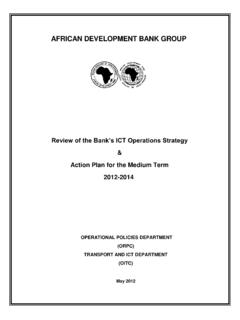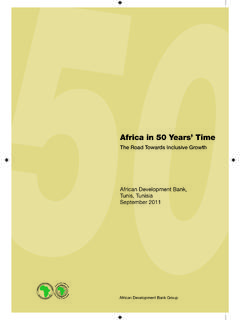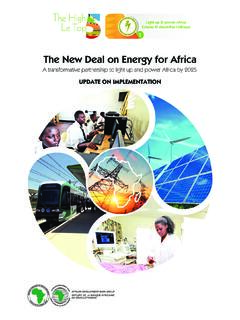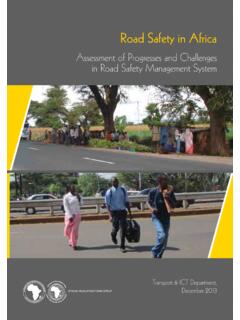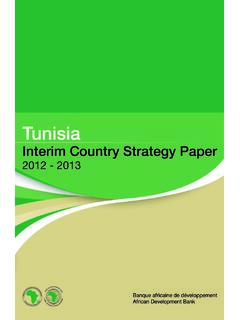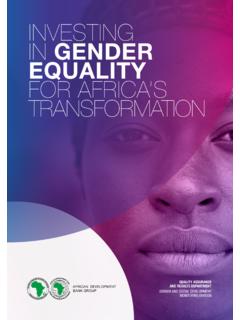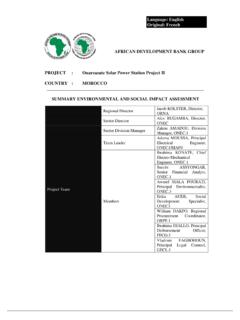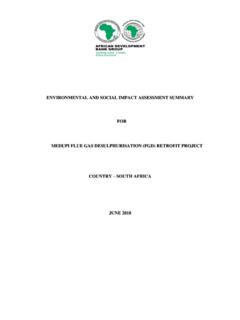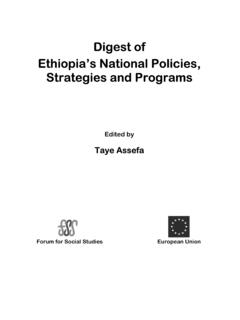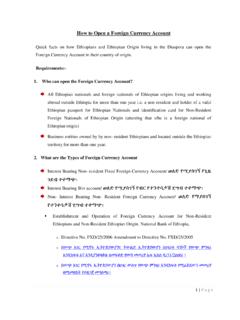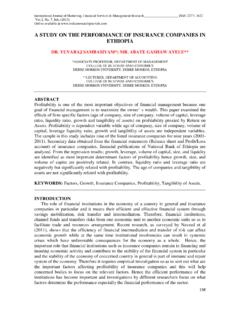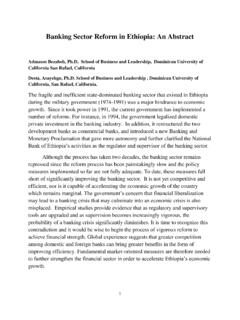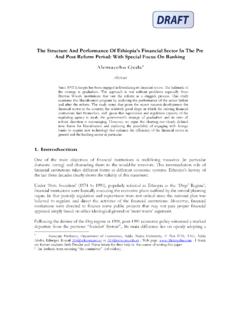Transcription of Outreach and Financial Performance Analysis of ...
1 Outreach and Financial Performance Analysis of microfinance institutions in ethiopia By: Befekadu B. Kereta national bank of ethiopia Economic Research and Monetary Policy Directorate E-mail: African Economic Conference United Nations Conference Center (UNCC), Addis Ababa, ethiopia 15-17 November 2007 2 Abstract ethiopia is one of the least developed countries. The per capita income of the country, though it showed improvement in recent years, is only USD 180 as at end of 2005/061. Most of the poor, which mainly argued to be constrained by absences of credit access, participant in some kind of informal sector ranging from small petty trading to medium scale enterprises.
2 Several micro finance institutions (MFIs) have established2 and have been operating towards resolving the credit access problem of the poor. In light of this, this paper attempted to look at MFIs Performance in the country from Outreach and Financial sustainability angles using data obtained from primary and secondary sources. The study finds that the industry's Outreach rise in the period from 2003 to 2007 on average by 22. 9 percent. It identified that while MFIs reach the very poor, their reach to the disadvantages particularly to women is limited ( Percent).
3 From Financial sustainability angle, it finds that MFIs are operational sustainable measured by return on asset and return on equity and the industry's profit Performance is improving over time. Similarly, using dependency ratio and Non-performing Loan (NPLs) to loan outstanding ratio proxies the study also finds that MFIs are Financial sustainable. Finally, it finds no evidence of trade-off between Outreach and Financial sustainability. 1 Source: national bank of ethiopia database. 2 The MFIs have been receiving licenses and supervised by NBE under the proclamation number of 40/1996.
4 3 Table of Contents Abstract .. 2 Table of Contents .. 3 Tables and Figures .. 4 Chapter 1- 5 Chapter 2- Literature review .. 8 Theoretical 8 Empirical literature review .. 13 Chapter 3- Empirical Analysis of 15 Structure of MFIs .. 15 Performance of MFIs .. 17 Outreach .. 17 Financial 20 Related Performance Indicators .. 24 Challenges of 26 Chapter 4- Conclusion and Policy Implications .. 28 References:.. 30 4 Tables and Figures Non-Performing Loan (NPL) to Loan Outstanding Figure : Market Share by Number of Figure : Market Share in Outstanding loan by Figure : Trend of Industry Figure : Outreach by each Figure : Client Poverty Figure : Women Credit Access Figure : Operational Sustainability measured by RoA and Figure : Tend of Dependency Ratio and Retained Earning to Capital Figure : Donation to Loan Figure.
5 Correlation Test Result between Number of Active Clients (NAC) and Profit Performance (PR) of MFIs on 2007 Figure : Correlation Test Result between Number of Active Clients (NAC) and Profit Performance (PR) of MFIs on 2006 Figure : Correlation Test Result between Number of Active Clients (NAC), Profit Performance (PR) and Average Loan Size (ALS) of MFIs on 2007 5 Chapter 1- Introduction ethiopia is one of the least developed countries. The per capita income of the country, though it showed improvement in recent years, is only USD 180 as at end of 2005/063.
6 This is very little money to cover daily meal, let alone health, education and other emergency expenses, which make the poor venerable to unforeseen illness expenses and others. There is also high level of unemployment even with the skilled labor force. For instance, according to 2004 World Development Indicators, out of the total unemployment of the active labor force , and percent have complete primary, secondary, and tertiary education, respectively. And, this unemployed population is increasing from time to time as the population of the country is increasing.
7 It is also the experience in the country that the poor households are the main participants in some kind of informal sector ranging from small petty trading to medium scale enterprises (Jean-Luc 2006). And due to the fact that this sector uses intensive labor force and as well since it is the livelihood of most of the poor, developing this sector argued to be a weapon to resolve the problem of unemployment and poverty of a household (Lakew 1998 and Jean-Luc 2006). Several studies noted different causes for poverty in a country. Some argued that the cause of poverty in developing economies among other things is that the poor does not have access to credit for the purpose of working capital as well as investment for its small business (Jean-Luc 2006).
8 To this end many developing economies have developed and have been providing credit to the poor through microfinance schemes. The experience of several Asian, African as well as Latin American countries could be a typical example for this (Meyer 2002). 3 Source: national bank of ethiopia database. 6 In ethiopia , several micro finance institutions (MFIs) have established4 and have been operating towards resolving the credit access problem of the poor particularly to those participates in the petty business.
9 In light of this, this paper attempts to look at MFIs Performance in the country. It aims to assess the Performance of micro finance institutions in ethiopia from different angles. Specifically it will attempt: To look at The MFIs Outreach to the poor and their Financial sustainability; To identify challenges faced by MFIs not to operate efficiently; and Finally, to deliver policy recommendations towards efficient operation of MFIs. Mostly argued that MFIs could not sustain for long with out the back funding of donors, federal government, regional government or others.
10 So, we raise the question does they really not sustain if the support is gone. To this end, assessment of MFIs Performance particularly answering if they are financially sustainable would be significant. Therefore, What ever the study finds out could be an input for policy making for improved operation of MFIs so as to promote sustainable poverty reduction as most target provision of credit to the poor. The data types used in the study are both secondary and primary data. The secondary data were obtained from the Association of Micro Finance institutions (AMFI) and national bank of ethiopia (NBE).

